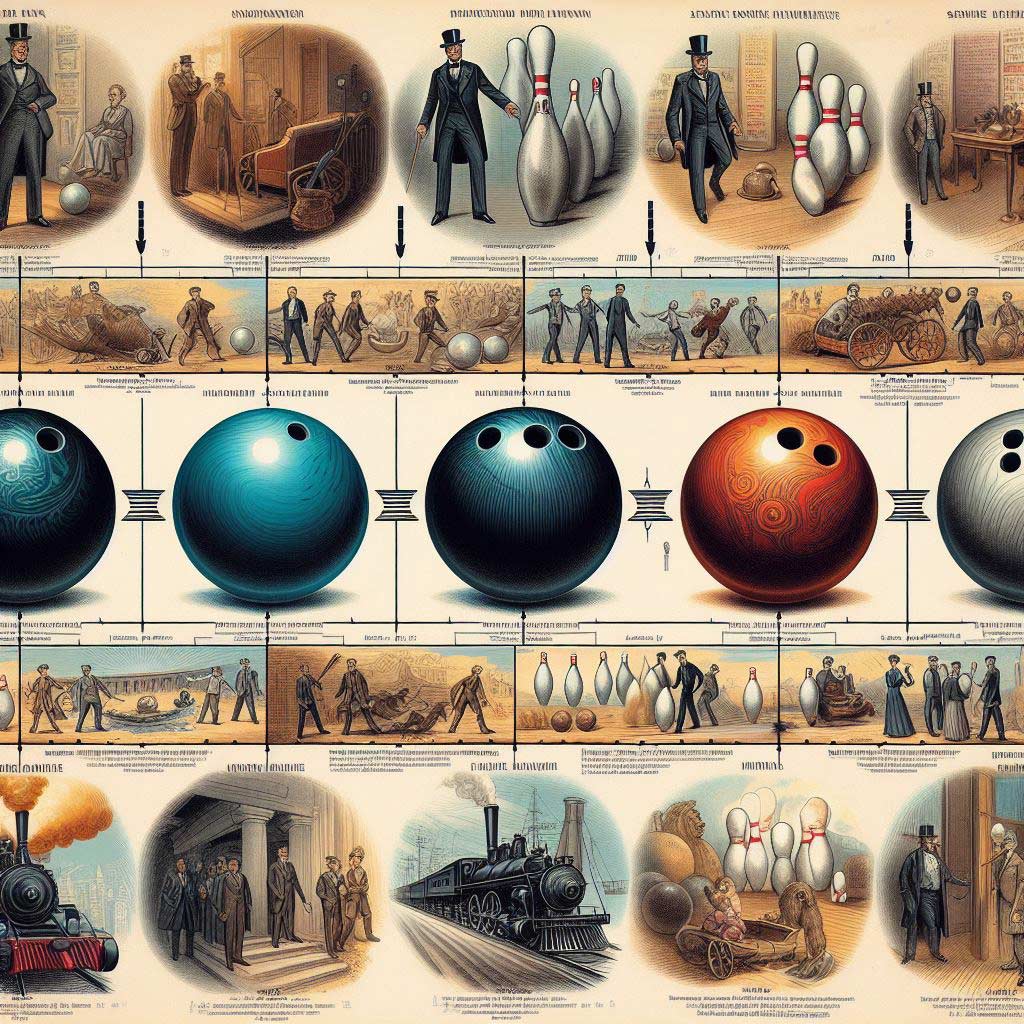Bowling is one of the most popular participatory sports in the world, with over 70 million people enjoying hitting the lanes every year. In the U.S. alone, over 50 million people bowl at least once a year! With such widespread popularity, many people don’t realize that bowling has a vibrant history that stretches back thousands of years.
From ancient Egypt to modern times, variations of bowling have provided entertainment and competition across cultures worldwide. While the contemporary form of 10-pin bowling is a relatively recent development, games involving rolling balls to knock down objects have existed since ancient history.
So how long exactly has bowling been a recognized sport? Let’s roll through the long and storied history of bowling!
The Ancient Origins of Bowling
Evidence suggests forms of bowling existed as early as 3200 BC during ancient Egyptian times. Depictions in Egyptian hieroglyphics portray figures rolling stones at targets.
The targets appeared to be clubs or pins of various configurations. Other archeological evidence from ancient Egypt shows recreational games involving tossing stones at targets.
The ancient Roman empire also participated in forms of bowling, albeit with a more militaristic twist. One variation called “bowls” involved soldiers lobbing stone balls at a target between armies. The first side to successfully knock over the target won.
In 400 AD, a children’s game called “kegel” emerged in Germany. It involved rolling a rock to knock over as many pins as possible. The pins were known as kegels, which gives the game its name. Kegel represented an early form of modern bowling.
In the Middle Ages, variations of bowling continued to evolve across Europe. In 1366, King Edward III allegedly prohibited the playing of bowling in London to keep citizens from neglecting their archery practice. Additional English kings and queens continued to ban bowling over the following century due to interference with military training.
Despite royal prohibitions, bowling remained popular across England and other European countries. The Dutch were particularly enthralled with bowling games and were among the first Europeans to bring bowling to colonial America.
Bowling Comes to America
When Dutch settlers came to America, they brought along variations of bowling played back in the Netherlands. Other colonists from England, Ireland, and Germany brought their own versions too. Bowling games began emerging across colonies in the 1600s.
The oldest indoor bowling alley still operating is located in New York. It first opened its doors in 1840 in lower Manhattan. At the time, it catered mainly to the Irish and German immigrants who lived nearby. The one-lane alley remains preserved in its original location known as the South Street Seaport.
While various bowling games existed, modern American ten-pin bowling came about in the mid-1800s. In 1841 the state of Connecticut banned nine-pin bowling due to associated gambling and unsavory behavior. However, creative bowlers got around the ban by adding a 10th pin, leading to the invention of 10-pin bowling.
In the following decades, bowling saw a surge in popularity across the eastern U.S. Many bowling centers opened in cities like New York, Philadelphia, Boston, and Baltimore. The game especially appealed to post-Civil War industrial workers looking for recreation.
The Formation of the American Bowling Congress
As bowling grew in popularity at the end of the 19th century, there was little consistency between the rules and equipment used in different locations. To standardize and organize the sport, the American Bowling Congress (ABC) formed on September 9, 1895 in New York City.
The first ABC interstate tournament occurred in Chicago in 1901. It featured representatives from Illinois, New York, Ohio, and Pennsylvania. Standardized rules from the tournament governed bowling nationwide.
In the early 1900s, the Women’s National Bowling Association formed among female bowling clubs that emerged. Eventually it joined forces with the ABC as interest in bowling as an organized sport surged.
Over the following decades, the ABC set standards for equipment specifications, scoring systems, events, and tournaments. The organization governed amateur bowling and defined what constituted professional versus recreational bowling. This paved the way for competitive bowling to flourish.
The Golden Age of Bowling
Bowling reached its peak popularity as a recreational pastime and professional sport between the late 1950s through the 1970s, considered the sport’s “Golden Age.”
During the prosperous post-war economic boom, families had more disposable income to spend on leisure activities like bowling. Land was readily available and inexpensive, enabling bowling lanes to be constructed across America.
The American Machine and Foundry Company (AMF) capitalized on bowling’s rising popularity by rapidly expanding locations and acquiring independent centers. In 1958, AMF owned a total of 136 lanes. By 1962 that number skyrocketed to over 12,000 lanes!
Overall, approximately 10,000 bowling centers with over 170,000 lanes existed across the United States by 1962. The number of bowling alleys doubled from over 5,000 in 1957 to over 10,000 locations in 1962.
Bowling began airing on broadcast television, turning top bowlers into sports celebrities. ABC’s “Make That Spare” ran from 1960-1964 and awarded contestants $100 for converting difficult splits. NBC’s “Jackpot Bowling” awarded $50,000 to bowlers for rolling 300 games.
Popular professional bowlers during this era included Don Carter, Dick Weber, Carmen Salvino, Billy Welu, and Eddie Elias. They competed professionally, made TV appearances, and were featured in product endorsements.
Pop Culture Embraces Bowling
Beyond broadcasts of professional bowling tournaments, bowling alleys, and bowlers made their way into mainstream television, movies, and music.
The Flintstones animated sitcom depicted lead characters Fred Flintstone and Barney Rubble as avid bowlers and members of a bowling league. Chubby Checker’s 1960 hit song “Twistin’ The Night Away” famously mentions “Sam’s Bowling Alley.” Dude bowling leagues and college bowling teams formed across America.
The 1970s TV sitcom “Laverne & Shirley” starring Penny Marshall and Cindy Williams centered around two female roommates who worked at the fictional Shotz Brewery in Milwaukee and bowled on their company team. It encapsulated bowling’s place in American pop culture.
The 1998 cult classic movie “The Big Lebowski” cemented bowling as cool. Jeff Bridges starred as laid-back bowling enthusiast “The Dude” who frequented the alley with his buddies.
Conclusion
Bowling has been a favorite recreational pastime and competitive sport for over 600 years! From ancient Egypt to modern bowling leagues, variations of bowling have been rolled out across cultures worldwide.
Standardization from organizations like the American Bowling Congress in 1895 helped bowling become a formalized sport. The popularity explosion during the Golden Age of Bowling in the 1950s and 1960s made bowling a beloved pastime.
Bowling has stood the test of time and remains one of the most popular sports today. Over 70 million people hit the lanes annually! Leagues, tournaments, celebrity bowlers, and pop culture references have further solidified bowling’s place in history.
The next time you go bowling with family or friends, remember you’re taking part in an activity people have enjoyed for centuries! As bowling continues to evolve, who knows what the future has in store for rolls, strikes, and spares.
Frequently Asked Questions
How long does it take to write a screenplay?
It typically takes 3-6 months for a professional screenwriter to write an original feature film screenplay. However, it can take amateur writers much longer, sometimes years.
How popular is bowling as a sport?
Bowling is one of the most participated in sports worldwide with over 90 million people bowling at least once a year. There are over 13,000 bowling centers and over 95,000 bowling lanes in the United States alone.
What is the #1 sport in the world?
Soccer/football is considered the most popular sport globally based on viewer interest and participation. An estimated 4 billion fans watched the 2018 FIFA World Cup.
Where does bowling rank as sports?
Bowling is considered one of the top 10 most participated in sports/activities in the United States, along with golf, basketball, tennis, and swimming.
What are the top 5 most watched sports in the US?
American football, basketball, baseball, ice hockey, auto racing.
Is bowling a sport yes or no?
Yes, bowling is considered a sport. It requires physical skill and dexterity, has standardized rules/scoring, and has professional/amateur leagues and competitions worldwide.
What percentage of people like bowling?
According to industry research, over 70 million people worldwide participate in bowling at least once per year. In the US, over 50 million people bowl per year, representing around 15% of the population.
What is America’s #1 sport?
American football is considered the most popular sport in the US based on television viewership, event attendance, revenues, and fan avidity.
What is the 3 most famous sport?
The 3 most famous sports in the world are widely considered to be soccer/football, basketball, and cricket. All have huge global followings and fanbases.
What is the #2 sport in the world?
Cricket is considered the 2nd most popular and watched sport globally, trailing only soccer/football in worldwide fans and participation.





